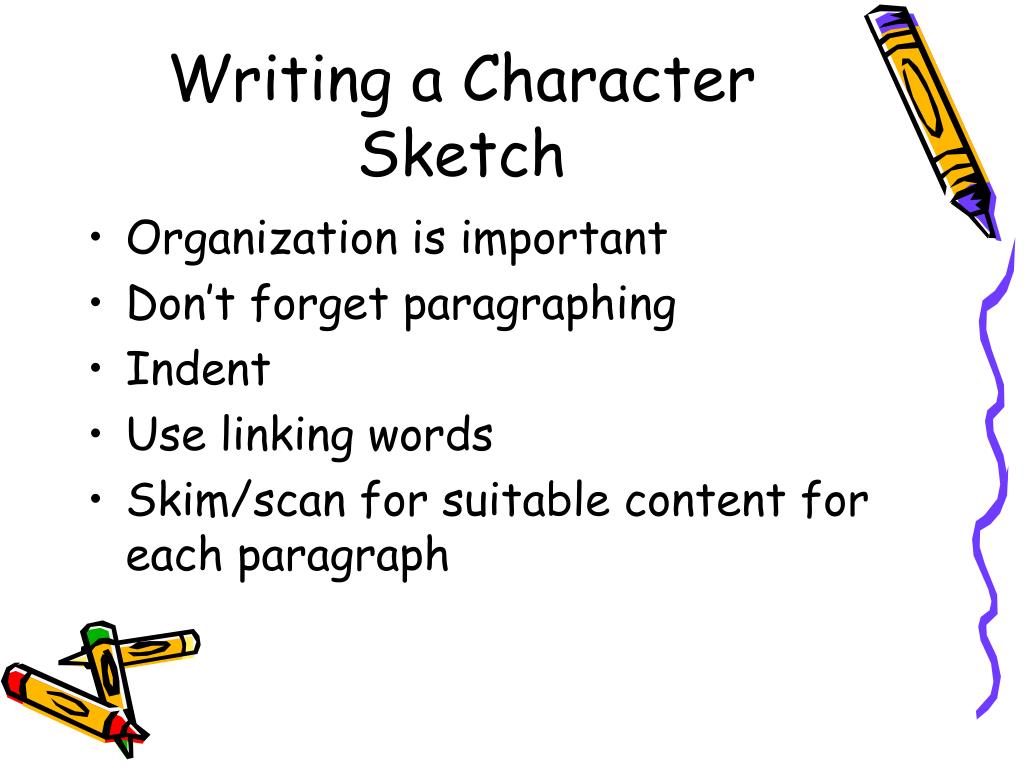

The students will be given 20-30 minutes to write their story.The teacher will have the students use particular transitional phrases to begin each of their paragraphs, which will help transition their writing from the beginning, to the middle, to the end.The story will need to be three paragraphs long and include the character, setting, and identify a problem the character will face. When students have finished filling out their character sketch, the teacher will explain to the students that they will need to write a story based on their character description.They will also be encouraged to use figurative language in their descriptions. As the students are writing their descriptions, the teacher will encourage students to use their writer’s portfolios to find synonyms for words to make their writing more descriptive.After each question, the students will be given allotted amount of time to write their thoughts down on the organizer and then will be able to share with the class.


The teacher will then display the piece of art the students will be writing about. The teacher will hand out the ‘Beautiful Creative Writing’ Character Sketch Writing Organizer.The teacher will ask students why it’s important to use description in the writing process? How does it make you become a better writer?.The teacher will begin by explaining that today’s objective in writing will be to write a descriptive story using a piece of art as a picture writing prompt.Writer’s Portfolios (thesaurus, descriptive words, transitional phrases).Beautiful Creative Writing Character Sketch descriptive writing organizer.Key Vocabulary:Adjectives, synonyms, antonyms, transition phrases, figurative language (emphasis on similes and personification), setting, character LA 4.2.1.b Generate a draft that develops a clear topic suited to the purpose and intended audience and organizational pattern, including a clear introduction, body, and conclusion with appropriate transitions.LA 4.2.1.d Compose paragraphs with grammatically correct sentences of varying length, complexity, and type.LA 4.2.2.d Use precise word choice and domain-specific vocabulary to write in a variety of modes.įine Arts Standard:FA 5.1.1.a Generate ideas for stories, events, or experiences that can be the basis of content for media arts (e.g., brainstorming, role-playing, discussion).FA 5.1.1.b Develop a process with timelines and roles using steps, vocabulary, and resources in creating media artsFA 5.1.2.b Explore how media arts elements and context enhance overall effectiveness and expression (e.g., image, sound, light, movement, time, space).FA 5.2.1.b Use observation, imagination and interpretation in creating artworks that reflect a variety of styles, themes, (glossary) and subjects.FA 5.2.1.c Demonstrate the connections between sensory experience (glossary) and expressing emotion Lesson Title: Beautiful Creative Writing Character Sketch Content Area: ELA/WritingĬontent Area Standard:LA 4.1.6.b Identify and describe elements of literary text (e.g., characters, setting, plot, point of view, theme).LA 4.1.6.c Identify and explain why authors use literary devices (e.g., simile, metaphor, alliteration, onomatopoeia, imagery, rhythm, personification, hyperbole, idioms).LA 4.2.1.a Use prewriting activities and inquiry tools to generate ideas, organize information, guide writing, and answer questions.


 0 kommentar(er)
0 kommentar(er)
